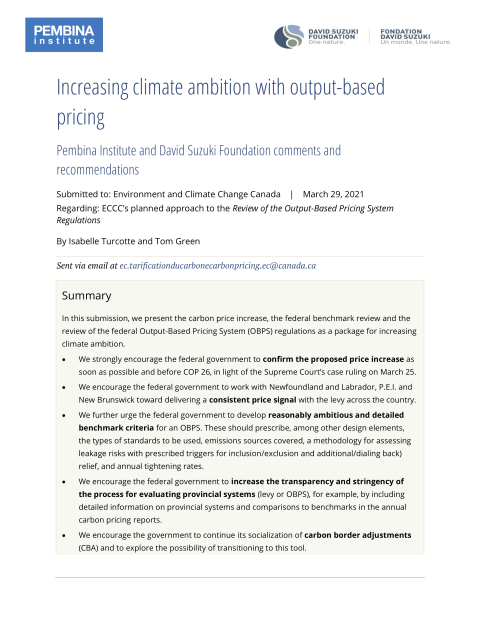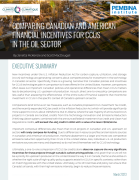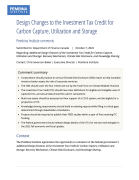In response to a request for feedback, Isabelle Turcotte, federal policy director at the Pembina Institute, and Tom Green, climate solutions policy analyst at the David Suzuki Foundation, made a submission to Environment and Climate Change Canada regarding ECCC’s planned approach to the Review of the Output-Based Pricing System Regulations.
Summary
In this submission, we present the carbon price increase, the federal benchmark review and the review of the federal Output-Based Pricing System (OBPS) regulations as a package for increasing climate ambition.
- We strongly encourage the federal government to confirm the proposed price increase as soon as possible and before COP 26, in light of the Supreme Court’s case ruling on March 25.
- We encourage the federal government to work with Newfoundland and Labrador, P.E.I. and New Brunswick toward delivering a consistent price signal with the levy across the country.
- We further urge the federal government to develop reasonably ambitious and detailed benchmark criteria for an OBPS. These should prescribe, among other design elements, the types of standards to be used, emissions sources covered, a methodology for assessing leakage risks with prescribed triggers for inclusion/exclusion and additional/dialing back) relief, and annual tightening rates.
- We encourage the federal government to increase the transparency and stringency of the process for evaluating provincial systems (levy or OBPS), for example, by including detailed information on provincial systems and comparisons to benchmarks in the annual carbon pricing reports.
- We encourage the government to continue its socialization of carbon border adjustments (CBA) and to explore the possibility of transitioning to this tool.
Ideally, a revised OBPS should be limited to sectors that warrant protection against substantiated leakage risks, with relief calibrated using an enhanced assessment framework; however, this scenario is out of reach given the time constraints of the OBPS review. Instead, we provide recommendations on other key determinants of the stringency of the OBPS system toward increasing the contribution of the federal OBPS to Canada’s climate target:
- We recommend the application of tightening rates that drive emissions reductions of 6-8% annually, aligned with the global carbon budget, informed by the review of emissions reductions technologies.
- Carbon pricing revenues should promote R&D for technology to reduce hard-to-abate emissions.
- We recommend including all sources of emissions (combustion, indirect, fugitives) in setting the standards.
- We also encourage the federal government to develop an approach for dealing with ecosystem emissions, which are currently not priced under the levy or the OBPS.
- We recommend setting a limit on offsets for meeting compliance that is consistent with maintaining a strong price signal (10-25%); emissions from forestry and agriculture should be regulated.
- We strongly encourage the federal government to remove electricity from the OBPS and to set a goal of reaching 100% clean electricity by 2035, in line with the U.S. If the OBPS system persists for electricity, we recommend that the standards be ratcheted down more rapidly, and that a tightening rate be applied to existing natural gas.









